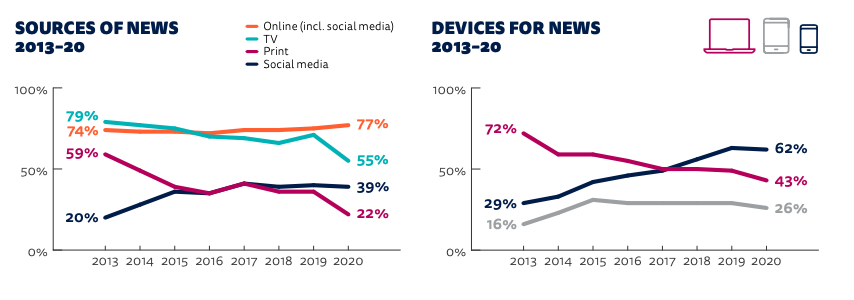How can trends in digital news affect specialist media businesses? The Digital News Report published by the RISJ is an excellent annual check on global trends in how people access news. But it does also highlight some shifts in behaviour that will become relevant to specialist publishers. These are five trends I suggest you watch.
1. Paid Content
The proportion of news consumers who have a digital subscription remains pretty low (outside the Nordics and the US) and is growing only slowly. While 20% of the US population pay for online news, this averages just 13% in 9 other western countries, and just 7% in the UK. Out of that 7%, 5% have just one digital subscription, so it is a bit of a winner takes all.
Around 5% of UK consumers make a donation to a news organisation, about half of this goes to The Guardian. Plus of course some of that 5% may be the same people who pay for a digital sub as well.
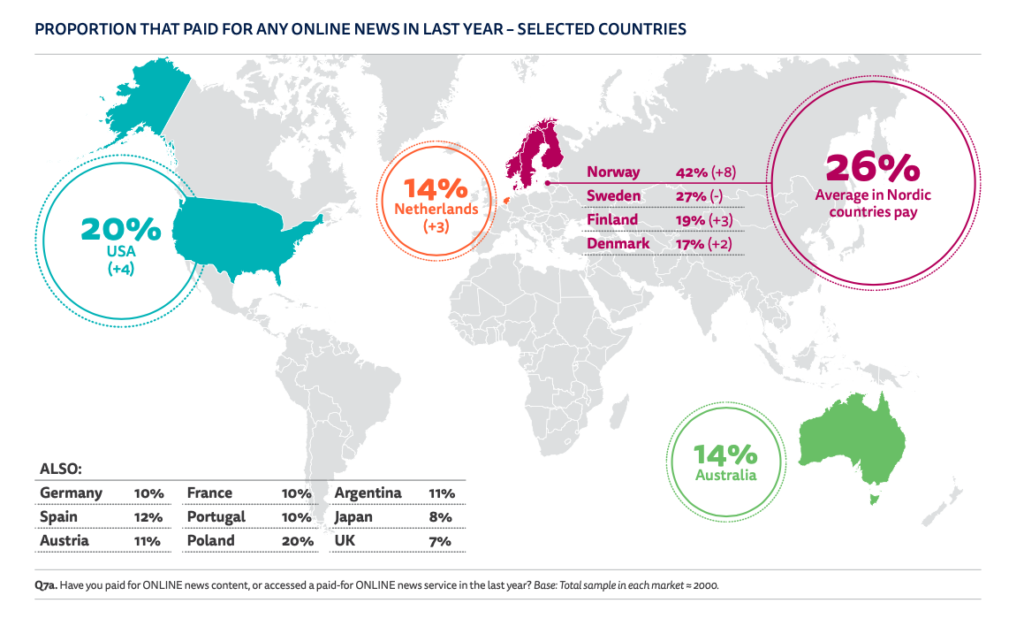
So paid content for news has yet to really take off. Those Brits who do subscribe give the following as their top reasons: quality journalism, specific journalists and a convenient package. Another popular reason is the wish to “fund good journalism.” What might persuade non-payers to subscribe? Top features are: no adverts, bundling with another service and (guess what) a lower price.
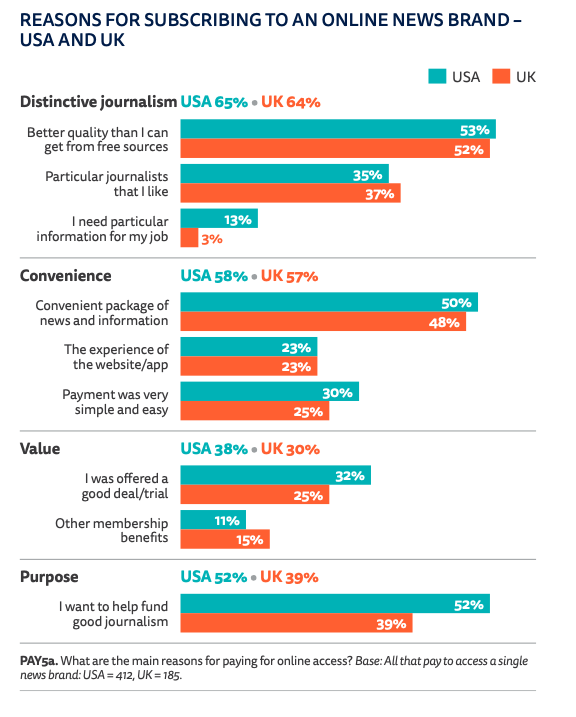
What is more encouraging is the (slightly grudging) support by 40% for registering for a news source in order to access some content for free. This approach was pioneered by The Economist and recently adopted by Times, Telegraph, and Spectator.
I have long believed that news organisations help wedge open the paid content doors that later benefit specialist publishers, so this does feel like a positive flag for experimenting with registration and metering, and, ultimately, paid subscriptions.
2. E-newsletters
The old school email newsletter is still considered an effective way to receive news updates. Worldwide, 96% receive scheduled e-newsletters, largely news-driven, but with 15% receiving a work related specialist email.
The best email newsletters are those that are treated as an editorial product, with a senior journalist providing a personal touch and careful curation. The New York Times morning newsletter has over 17m subscribers. Closer to home, Politico’s London playbook has a very respectable 50,000.
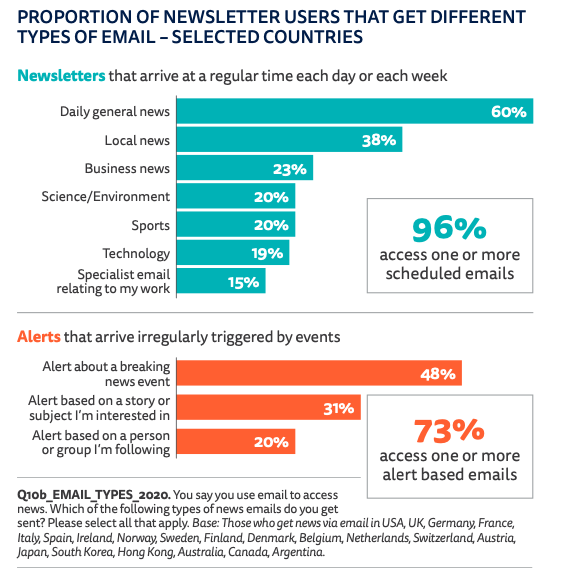
Emails also appear to help build loyalty among subscribers – in the UK 27% of paid subscribers access news via email.
It looks like e-newsletters remain a useful tool for both prospecting and developing loyalty. One caveat, they are far more popular among the over 45s, so it depends on your audience.
3. Access to news stories
Smartphones continue to be the most popular device for accessing news (62% in UK) well ahead of computers at 43%. Meanwhile print is down to 22%.
Only 28% of news is consumed directly from the website, with the balance from social media (26%) and search (25%) followed by mobile alerts and aggregators. The tilt towards social and search is more exaggerated for younger age groups.
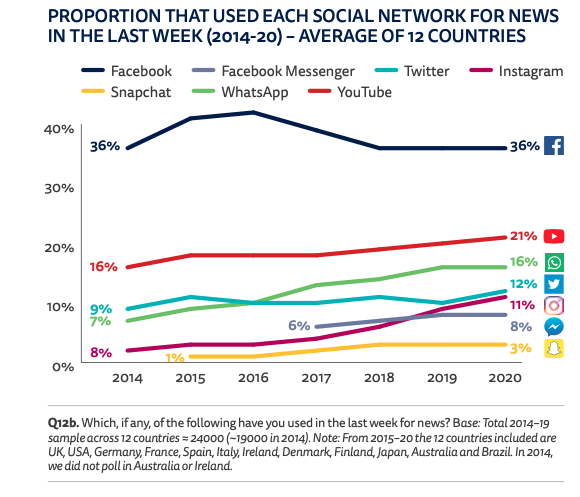
The two fastest growing social networks for news, quickly approaching the leaders Facebook and YouTube, are WhatsApp (16%) and Instagram (11%). Instagram looks set to soon overtake twitter, certainly among younger groups. In the UK, 24% of 18-24s used Instagram as a source of Coronavirus news in April 2020.
So if you have a younger audience profile, it may well pay to promote digital content across a range of social media, rather than focus simply on Facebook and twitter.
4. Podcasts
The UK is not as enamoured with podcasts as the US, but all the same 31% accessed a podcast in the past month. And podcast listenership is double the rate among <34s as it is among 35-54s. So again, if your demographic is younger (or you want to move it in that direction) it’s definitely a channel to explore.
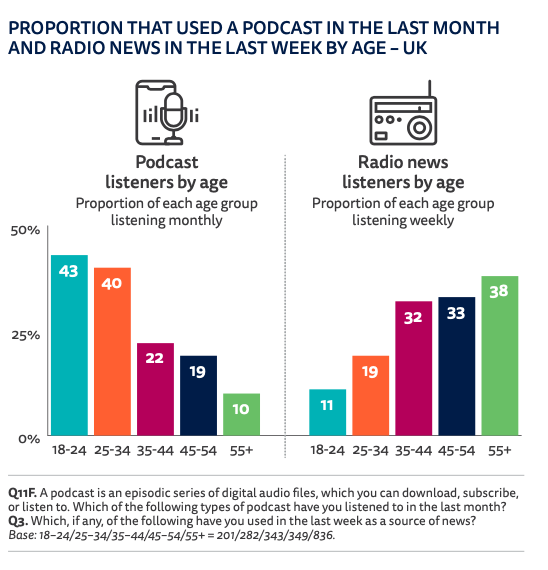
The top three podcast platforms in the UK are BBC Sounds, Apple and Spotify. If we follow the US, then specialist and leisure topics (health, tech, business, food, fashion, celebs) will be as popular as news and current affairs.
5. Visual and data journalism
Visual journalism has been growing, driven in part by the growth in Instagram and the “story” format. Publishers are increasingly creating graphics and explainers to communicate more complex stories. And the coronavirus epidemic has brought high quality data journalism to the fore, such as the FT and Economist’s mortality trackers.
For specialist publishers, this probably just amplifies a trend that was already underway, but it is a useful reminder than in the mobile, social world, a picture often tells a story best.
If you want to read the entire RISJ report (all 100+ pages) it is available here.
If you’d like to discuss how to develop your digital publishing strategy to take advantage of some of these trends, do get in touch for a chat over a (virtual) coffee.
About the author
Carolyn Morgan has bought, sold, launched and grown specialist media businesses across print, digital and live events. A founder of the Specialist Media Show (sold in 2014) she now advises media businesses large and small on their digital strategy through her consultancy Speciall Media.

